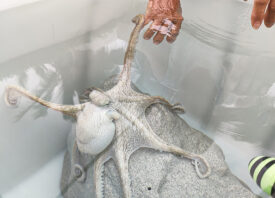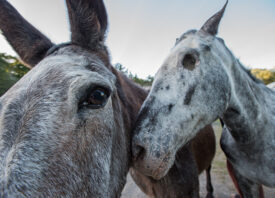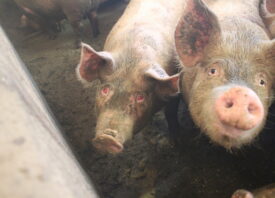Search this site
Rescued Farm Animals Up Close and Personal

Water buffalo, like many animals, are often farmed for meat or dairy. Buffalo Bill was no exception; the original plan was for him to be used for meat product. But after months of nursing the infant buffalo, the family who owned the small farm where Bill lived decided they could not send him to slaughter.
Instead, they kept him as a pet. Buffalo Bill grew up to become a gentle giant; weighing in at more than a ton now, he can be found snuggling with the family’s youngest daughter. He has also embarked on the journey of becoming a therapy animal.
Bill is just one of the extraordinary farm animals featured in the photographer Traer Scott’s book Radiant: Farm Animals Up-Close and Personal. On every page, you’ll find portraits of rescued farm animals who have been given a second chance at happiness.
In return, each of them has enriched the lives of the people who’ve rescued them. Today, some live as pets in private homes, and many have been taken into farm animal sanctuaries, where they will be safe for the rest of their lives.
Much like dogs, cats, and other domestic animals, these farm animals have personalities, feelings, and desires. There’s Wyatt, the twenty-five-year-old cow who loves being brushed, and Bobbert the alpaca, who gives kisses. Spot the duck greets visitors to his sanctuary by waddling right up to their cars. Penny the goat comes whenever she hears someone call her name. Bean the goat sleeps at the foot of his human’s bed at night.

Unlike cats and dogs, however, many of these animals were destined for slaughter. Most of their species live and die in factory farms, where they never get to go outside and breathe fresh air; often, they’re kept in conditions so confining that they can’t even turn around. Disease runs rampant.
Some of the animals featured in Radiant are shy, possibly due to cruelty in their pasts, but others are outgoing and curious. A few of them have passed away since Scott first met them, but most continue to live fulfilling and free-roaming lives with people and other animals who love them. Despite the odds, each of these animals have found joy and peace.

Ben David the pig was separated from his biological mother at birth; when he arrived at the sanctuary, he was taken in by a rescued gestation sow, who became his surrogate mother. Amelia, a pig rescued from a convicted animal abuser, sometimes playfully steals tools from people working around the farm.
As for Buffalo Bill, he receives visits from the photographer every few months. She’s grown attached to all the animals in the book, but he holds a unique place in her heart. “I like to think he remembers me when he sees me,” she tells me. “But he’s nice to everyone, so who knows!”
Most of us will never get the chance to meet and nurture a baby water buffalo–or cow, sheep, pig, llama, chicken, duck, or turkey–but through Radiant, we can get one step closer to understanding these overlooked animals. We asked Scott some questions about the project. You can get your copy of the book here.

Might you tell us a bit about your personal history with farm animals?
“I really had very little interaction with farm animals as a kid, but when I was in my mid 20’s, I did a photo essay out at Farm Sanctuary that was about the human/animal bond.
“Around that same time, I also made a friend who owned a small farm in Massachusetts. Over the years, I began taking all of my adult photo classes to her farm to shoot an assignment. The result was always astounding. Usually, at least one student would break down in tears and vow to never eat pork again after hanging with the pigs all afternoon.
“I found this powerful and inspiring, and I realized that personal experience is often the key. I wanted to make a book for animal lovers that may have become disconnected from nature, a book that hopefully simulates an up-close, intimate encounter with farm animals so that the viewer might have the same epiphany or dawning of conscious compassion that my students often had.”

What surprised you most while working on Radiant?
“I was particularly surprised by the turkeys. You hear that turkeys are dumb and just bird automatons, but that’s just not true. They can form beautiful bonds with people when given a chance. They are very social and extremely funny.
“I met a turkey who loved hugs, who ran out to greet every car that came to visit at the sanctuary and gobbled in response to people laughing. So it’s particularly hard to know that 46 million turkeys are eaten every Thanksgiving. That makes me sad because the numbers are just so inconceivably huge. But I’m heartened to see more and more people choosing plant-based alternatives.”
What’s your most powerful memory from your time working on Radiant?
“Well, I write in the introduction about lying on the grass at Farm Sanctuary. It was a beautiful summer day, and while I was photographing chickens, I took a break and laid down in the lush grass just letting them peck and coo around me. The cooing, humming voices of fifteen or so chickens as they slowly and quietly went about their day around my body which was so rooted, in that moment, to the soil and the earth, was a transcendent thing.”

Have the sanctuary owners seen the book, and if so, what have their responses been like?
“Yes, most of the sanctuary folks have seen the book, and they have been very moved by it. Running a sanctuary and caring for animals is not a job; it’s a round-the-clock life that you never really get a vacation from. I think when they see their animals honored in the books, it makes them proud of the work they’re doing and perhaps brings a little more joy and validation to daily chores.”

You’ve dedicated the book to your eight-year-old daughter, Agatha. Does she also connect with animals?
“She very much connects with animals. Our family is vegetarian (I am vegan), and now that she is older and knows more about the reasons why we don’t eat meat, she has become rather strong in her views.
“Unfortunately, with awareness also comes sadness, and she has begun to experience that a lot in the past year. When they are asked to draw turkeys for Thanksgiving, or she goes to a family holiday that has a ham or a turkey as the main attraction, she gets really bummed out.
“No parent likes seeing their child hurting, so I am trying to give her reasons to be hopeful rather than overwhelmed, but at her age, there are very few vegetarians because kids eat whatever their parents and their school gives them. Sadly, there are almost no vegetarian lunch options at her school. I am working to change that.
“When my daughter was two, we were on vacation at Prudence Island, a tiny island off the coast of Rhode Island, and we were out for a drive and saw a pasture of dairy cows that belonged to a small family farm. I pulled over and took my daughter to go see the cows near the fence. We have always raised her vegetarian, but, at that point, she didn’t know why.
“I told her that many people eat cows. She looked at me with such a look of incredulity and said, ‘nahhhhh.’ She thought I was joking because she couldn’t believe that people ate animals. That was a decisive moment for me.
“I realized how much our society and culture has normalized the killing of animals for food, something that isn’t necessarily innate at all. We start feeding our children meat before they have any opinion or knowledge of what they’re eating and then by the time they’re old enough to understand, it just becomes ‘what people do.’”

Is there a question you wish I’d asked that I didn’t?
“Yes! Do you have to be vegetarian or vegan to enjoy Radiant? The answer is no, not at all. One of the reasons that the text in the book focuses on factory farming rather than trying to force people to be vegan is that I am a realist.
“I do not believe that everyone can or will choose to go vegan, but I do think that the ending factory farming is something that everyone can and should get behind. Industrial animal agriculture is destroying the environment, producing unhealthy food, and causing untold suffering to hundreds of millions of animals.
“So while I certainly hope that every single reader makes a connection with the animals in the book, I think that connection or fondness or awareness can bloom in a myriad of different ways–and they are all good.”
You can follow Scott on Instagram at @traer_scott.


